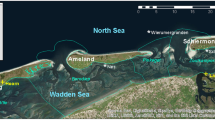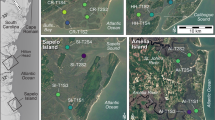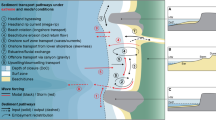Abstract
We reconstruct past accretion rates of a salt marsh on the island of Sylt, Germany, using measurements of the radioisotopes 210Pb and 137Cs, as well as historical aerial photographs. Results from three cores indicate accretion rates varying between 1 and 16 mm year−1. Comparisons with tide gauge data show that high accretion rates during the 1980s and 1990s coincide with periods of increased storm activity. We identify a critical inundation height of 18 cm below which the strength of a storm seems to positively influence salt marsh accretion rates and above which the frequency of storms becomes the major factor. In addition to sea level rise, we conclude that in low marsh zones subject to higher inundation levels, mean storm strength is the major factor affecting marsh accretion, whereas in high marsh zones with lower inundation levels, it is storm frequency that impacts marsh accretion.













Similar content being viewed by others
References
Ahrendt, K. and R. Köster. 1998. Sylt—einst und jetzt. In Umweltatlas Wattenmeers, Band 1, Nordfriesisches und Dithmarscher Wattenmeer, eds. Nationalpark Schleswig-Holsteinisches Wattenmeer (Tönning) and Umweltbundesamt (Berlin), 38–39. Stuttgart: Eugen Ulmer.
Ahrendt, K., and J. Thiede. 2001. Naturräumliche Entwicklung Sylts—Vergangenheit und Zukunft. In Sylt—Klimafolgen für Mensch und Küste, ed. A. Daschkeit and P. Schottes, 69–112. Berlin: Springer.
Allen, J.R.L. 2000. Morphodynamics of Holocene salt marshes: A review sketch from the Atlantic and Southern North Sea coasts of Europe. Quaternary Science Reviews 19: 1155–1231.
ALW—Amt für Land- und Wasserwirtschaft Husum. 1997. Fachplan Küstenschutz Sylt—Fortschreibung. Husum: ALW.
Andersen, T.J., O.A. Mikkelsen, A.L. Møller, and P. Morten. 2000. Deposition and mixing depths on some European intertidal mudflats based on 210Pb and 137Cs activities. Continental Shelf Research 20: 1569–1591.
Appleby, P.G., and F. Oldfield. 1978. The calculation of lead-210 dates assuming a constant rate of supply of unsupported 210Pb to the sediment. Catena 5: 1–8.
Appleby, P.G., and F. Oldfield. 1983. The assessment of 210Pb data from sites with varying sediment accumulation rates. Hydrobiologia 103: 29–35.
Armentano, T.V., and G.M. Woodwell. 1975. Sedimentation rates in a Long Island marsh determined by 210 Pb dating. American Society of Limnology and Oceanography 20: 452–456.
Bartholdy, J., C. Christiansen, and H. Kunzendorf. 2004. Long term variations in backbarrier salt marsh deposition on the Skallingen peninsula—the Danish Wadden Sea. Marine Geology 203: 1–21.
Bartholdy, J., J.B.T. Pedersen, and A.T. Bartholdy. 2010. Autocompaction of shallow silty salt marsh clay. Sedimentary Geology 223: 310–319.
Bartholomä, A., A. Kubicki, T. Badewien, and B. Flemming. 2009. Suspended sediment transport in the German Wadden Sea—seasonal variations and extreme events. Ocean Dynamics 59: 213–225.
Bellucci, L.G., M. Frignani, J.K. Cochran, S. Albertazzi, L. Zaggia, G. Cecconi, and H. Hopkins. 2007. Pb-210 and Cs-137 as chronometers for salt marsh accretion in the Venice Lagoon—links to flooding frequency and climate change. Journal of Environmental Radioactivity 97: 85–102.
Beniston, M., D. Stephenson, O. Christensen, C. Ferro, C. Frei, S. Goyette, K. Halsnaes, T. Holt, K. Jylhä, B. Koffi, J. Palutikof, R. Schöll, T. Semmler, and K. Woth. 2007. Future extreme events in European climate: An exploration of regional climate model projections. Climatic Change 81: 71–95.
BSH—Bundesamt für Seeschifffahrt und Hydrographie. 2008. Gezeitentafeln 2009—Europäische Gewässer. Hamburg: BSH.
Cahoon, D.R., and D.J. Reed. 1995. Relationships among marsh surface topography, hydroperiod, and soil accretion in a deteriorating Louisiana salt marsh. Journal of Coastal Research 11: 357–369.
Callaghan, D.P., T.J. Bouma, P. Klaassen, D. Van der Wal, M.J.F. Stive, and P.M.J. Herman. 2010. Hydrodynamic forcing on salt-marsh development: Distinguishing the relative importance of waves and tidal flows. Estuarine, Coastal and Shelf Science 89: 73–88.
Chmura, G.L., A. Coffey, and R. Crago. 2001. Variation in surface sediment deposition on salt marshes in the Bay of Fundy. Journal of Coastal Research 17: 221–227.
Church, J., and N. White. 2011. Sea-level rise from the late 19th to the early 21st century. Surveys in Geophysics 32: 585–602.
Church, J., N. White, T. Aarup, W. Wilson, P. Woodworth, C. Domingues, J. Hunter, and K. Lambeck. 2008. Understanding global sea levels: Past, present and future. Sustainability Science 3: 9–22.
Compton, A.H. 1923. A quantum theory of the scattering of X-rays by light elements. Physical Review 21: 483–502.
Delaune, R.D., W.H. Patrick, and R.J. Buresh. 1978. Sedimentation rates determined by 137Cs dating in a rapidly accreting salt marsh. Nature 275: 532–533.
Dijkema, K.S. 1987. Geography of salt marshes in Europe. Zeitschrift Fur Geomorphologie 31: 489–499.
Fischer-Bruns, I., H. Storch, J. González-Rouco, and E. Zorita. 2005. Modelling the variability of midlatitude storm activity on decadal to century time scales. Climate Dynamics 25: 461–476.
French, J.R. 1993. Numerical simulation of vertical marsh growth and adjustment to accelerated sea-level rise, North Norfolk, U.K. Earth Surface Processes and Landforms 18: 63–81.
French, J. 2006. Tidal marsh sedimentation and resilience to environmental change: Exploratory modelling of tidal, sea-level and sediment supply forcing in predominantly allochthonous systems. Marine Geology 235: 119–136.
French, J.R., and T. Spencer. 1993. Dynamics of sedimentation in a tide-dominated backbarrier salt marsh, Norfolk, UK. Marine Geology 110: 315–331.
Goodbred, S.L., and S.A. Kuehl. 1998. Floodplain processes in the Bengal Basin and the storage of Ganges-Brahmaputra river sediment: An accretion study using 137Cs and 210Pb geochronology. Sedimentary Geology 121: 239–258.
Harrison, E.Z., and A.L. Bloom. 1977. Sedimentation rates on tidal salt marshes in Connecticut. Journal of Sedimentary Research 47: 1484–1490.
He, Q., and D.E. Walling. 1996a. Interpreting particle size effects in the adsorption of 137Cs and unsupported 210Pb by mineral soils and sediments. Journal of Environmental Radioactivity 30: 117–137.
He, Q., and D.E. Walling. 1996b. Use of fallout Pb-210 measurements to investigate longer-term rates and pattern of overbank sediment deposition on the floodplains of lowland rivers. Earth Surface Processes and Landforms 21: 141–154.
Hildebrandt, V., J. Gemperlein, U. Zeltner, and W. Peteresen. 1993. Landesweite Biotopkartierung—Kreis Nordfriesland: Landschaftsentwicklung—Aktuelle Situation—Flächenschutz. Kiel: Landesamt für Naturschutz und Landschaftspflege Schleswig-Holstein.
Jensen, J., and C. Mudersbach. 2004. Zeitliche Änderungen in den Wasserstandszeitreihen an den Deutschen Küsten. In Klimaänderung und Küstenschutz, Conference proceedings, ed. G. Gönnert, H. Grassl, D. Kelletat, H. Kunz, B. Probst, H. von Storch, and J. Sündermann, 115–128. Hamburg. http://coast.gkss.de/staff/storch/material/kliku.2004.pdf.
Kelletat, D. 1992. Coastal erosion and protection measures at the German North Sea Coast. Journal of Coastal Research 8: 699–711.
Kirchner, G., and H. Ehlers. 1998. Sediment geochronology in changing coastal environments: Potentials and limitations of the 137Cs and 210Pb methods. Journal of Coastal Research 14: 483–492.
Kirwan, M.L., and G.R. Guntenspergen. 2010. Influence of tidal range on the stability of coastal marshland. Geophysical Research Letters 115: F02009.
Kirwan, M., and S. Temmerman. 2009. Coastal marsh response to historical and future sea-level acceleration. Quaternary Science Reviews 28: 1801–1808.
Kirwan, M.L., G.R. Guntenspergen, A. D’Alpaos, J.T. Morris, S.M. Mudd, and S. Temmerman. 2010. Limits on the adaptability of coastal marshes to rising sea level. Geophysical Research Letters 37: L23401.
Koide, M., A. Soutar, and E.D. Goldberg. 1972. Marine geochronology with 210Pb. Earth and Planetary Science Letters 14: 442–446.
Kolker, A.S., S.L. Goodbred Jr., S. Hameed, and J.K. Cochran. 2009. High-resolution records of the response of coastal wetland systems to long-term and short-term sea-level variability. Estuarine, Coastal and Shelf Science 84: 493–508.
Kunzendorf, H., K.-C. Emeis, and C. Christiansen. 1998. Sedimentation in the Central Baltic Sea as viewed by non-destructive Pb-210-dating. Geografisk Tidsskrift 98: 1–8.
Loebl, M., J. Beusekom, and K. Reise. 2006. Is spread of the neophyte Spartina anglica recently enhanced by increasing temperatures? Aquatic Ecology 40: 315–324.
Malvern Instruments Ldt. 2010. Mastersizer 2000. http://www.malvern.de/LabGer/products/Mastersizer/MS2000/mastersizer2000.htm. Accessed 31 Aug 2010.
Mariotti, G.A., and S. Fagherazzi. 2010. A numerical model for the coupled long-term evolution of salt marshes and tidal flats. Journal of Geophysical Research 115: F01004.
Milne, G.A., A.J. Long, and S.E. Bassett. 2005. Modelling Holocene relative sea-level observations from the Caribbean and South America. Quaternary Science Reviews 24: 1183–1202.
Möller, I. 2006. Quantifying saltmarsh vegetation and its effect on wave height dissipation: Results from a UK East coast saltmarsh. Estuarine, Coastal and Shelf Science 69: 337–351.
Mudd, S.M., A. D’Alpaos, and J.T. Morris. 2010. How does vegetation affect sedimentation on tidal marshes? Investigating particle capture and hydrodynamic controls on biologically mediated sedimentation. Journal of Geophysical Research 115: F03029.
Nikulina, A. 2008. The imprint of anthropogenic activity versus natural variability in the fjords of Kiel Bight: Evidence from sediments. Ph.D. thesis, University of Kiel.
Orson, R., W. Panageotou, and S.P. Leatherman. 1985. Response of tidal salt marshes of the U.S. Atlantic and Gulf Coasts to rising sea levels. Journal of Coastal Research 1: 29–37.
Pedersen, J.B.T., and J. Bartholdy. 2007. Exposed salt marsh morphodynamics: An example from the Danish Wadden Sea. Geomorphology 90: 115–125.
Pedersen, J.B.T., J. Bartholdy, and C. Christiansen. 2007. 137Cs in the Danish Wadden Sea: Contrast between tidal flats and salt marshes. Journal of Environmental Radioactivity 97: 42–56.
Pethick, J.S. 1981. Long-term accretion rates on tidal salt marshes. Journal of Sedimentary Research 51: 571–577.
Redfield, A.C. 1972. Development of a New England salt marsh. Ecological Monographs 42: 201–237.
Reed, D.J. 1995. The response of coastal marshes to sea-level rise: Survival or submergence? Earth Surface Processes and Landforms 20: 39–48.
Reise, K., M. Baptist, P. Burbridge, N. Dankers, L. Fischer, B. Flemming, A.P. Oost, and C. Smit. 2010. The Wadden Sea—a universally outstanding tidal wetland. Wadden Sea Ecosystem 29, 7–24. Wilhelmshaven: Common Wadden Sea Secretariat.
Rockel, B., and K. Woth. 2007. Extremes of near-surface wind speed over Europe and their future changes as estimated from an ensemble of RCM simulations. Climatic Change 81: 267–280.
Temmerman, S., G. Govers, P. Meire, and S. Wartel. 2003a. Modelling long-term tidal marsh growth under changing tidal conditions and suspended sediment concentrations, Scheldt estuary, Belgium. Marine Geology 193: 151–169.
Temmerman, S., G. Govers, S. Wartel, and P. Meire. 2003b. Spatial and temporal factors controlling short-term sedimentation in a salt and freshwater tidal marsh, Scheldt estuary, Belgium, SW Netherlands. Earth Surface Processes and Landforms 28: 739–755.
The Trilateral Monitoring and Assessment Program—TMAP. 2006. Ubgkal07: Topographie DK und SH. Nationalpark Schleswig-Holsteinisches Wattenmeer. http://www.waddensea-secretariat.org/TMAP/Data-Unit/Data.html. Accessed 20 Nov 2008
van de Koppel, J., D. van der Wal, J.P. Bakker, and P.M.J. Herman. 2005. Self-organization and vegetation collapse in salt marsh ecosystems. American Naturalist 165: E1–E12.
von Storch, H., and R. Weisse. 2008. Regional storm climate and related marine hazards in the Northeast Atlantic. In Climate extremes and society, ed. H.F. Diaz and R.J. Murnane, 54–73. Cambridge: Cambridge University Press.
Wahl, T., J. Jensen, T. Frank, I. D. Haigh. 2011. Improved estimates of mean sea level changes in the German Bight over the last 166 years. Ocean Dynamics 61:701–715.
Wahl, T., J. Jensen, and T. Frank. 2010. On analysing sea level rise in the German Bight since 1844. Natural Hazards and Earth System Sciences 10: 171–179.
Walling, D.E., A.L. Collins, and H.M. Sichingabula. 2003. Using unsupported lead-210 measurements to investigate soil erosion and sediment delivery in a small Zambian catchment. Geomorphology 52: 193–213.
Williams, H. 2003. Modeling shallow autocompaction in coastal marshes using cesium-137 fallout: Preliminary results from the Trinity River Estuary, Texas. Journal of Coastal Research 19: 180–188.
Winterwerp, J.C. 2002. On the flocculation and settling velocity of estuarine mud. Continental Shelf Research 22: 1339–1360.
Woth, K., R. Weisse, and H. von Storch. 2006. Climate change and North Sea storm surge extremes: An ensemble study of storm surge extremes expected in a changed climate projected by four different regional climate models. Ocean Dynamics 56: 3–15.
WSA—Wasser- und Schifffahrtsamt Tönning. 2007. Wasserstandsinformationen: Hörnum/Sylt. http://www.wsv.de/wsa-toe/service/wasserstandinfo/index.html. Accessed 27 Aug 2010.
Acknowledgments
This project was funded by the Cluster of Excellence 80 “The Future Ocean.” The “Future Ocean” is funded within the framework of the Excellence Initiative by the Deutsche Forschungsgemeinschaft on behalf of the German federal and state governments. Furthermore, we would like to thank Anton Eisenhauer for his support and the “Laboratory for Radioisotopes” in Goettingen for running the radiometric measurements. For their help in the field and during the preparation of the samples, we thank Daniela Arp, Michal Lichter, Tina Geissler, Natalia Zamora, and Claudia Wolff. The hydrological data for the tide gauge Hörnum Hafen were kindly supplied by Thomas Wahl, Jacobus Hofstede, and Gerd Hartwig. We would also like to thank the two anonymous reviewers for their valuable comments, which have helped in improving this manuscript.
Author information
Authors and Affiliations
Corresponding author
Rights and permissions
About this article
Cite this article
Schuerch, M., Rapaglia, J., Liebetrau, V. et al. Salt Marsh Accretion and Storm Tide Variation: an Example from a Barrier Island in the North Sea. Estuaries and Coasts 35, 486–500 (2012). https://doi.org/10.1007/s12237-011-9461-z
Received:
Revised:
Accepted:
Published:
Issue Date:
DOI: https://doi.org/10.1007/s12237-011-9461-z




